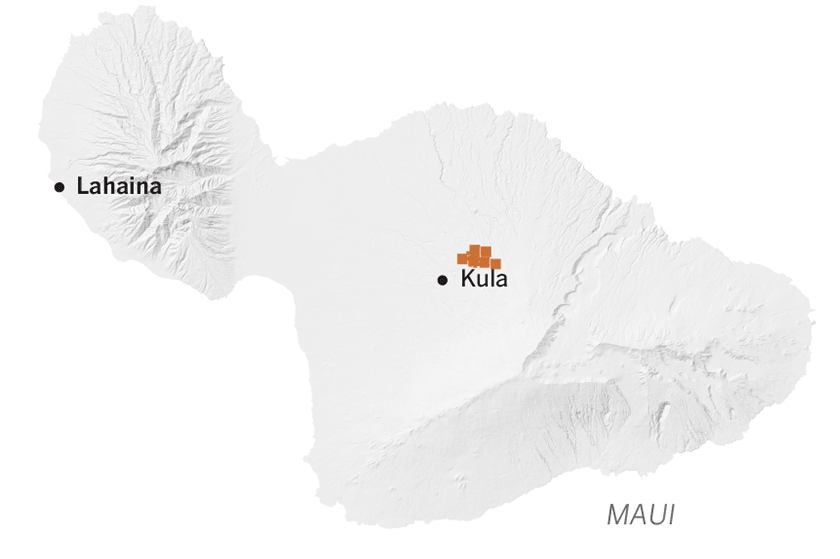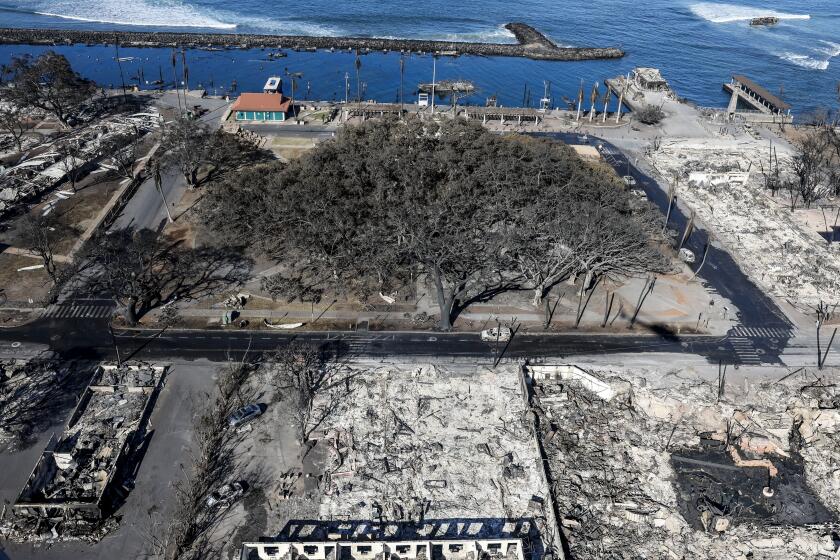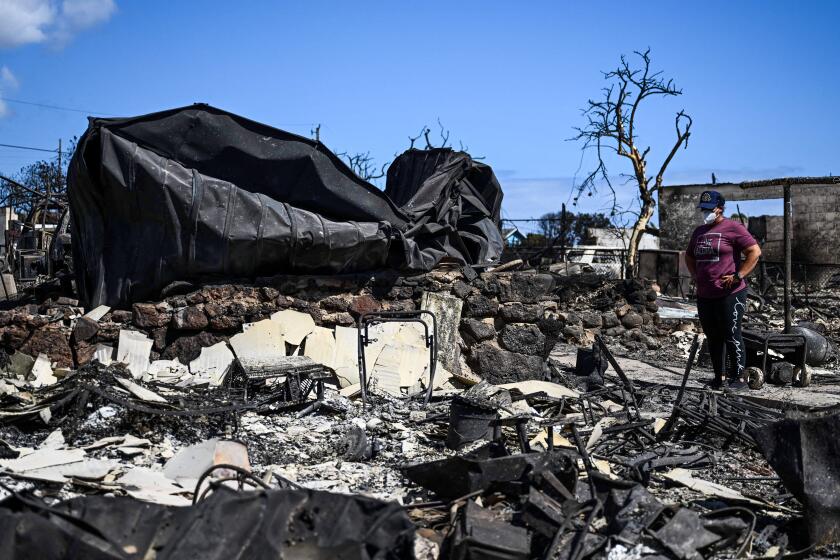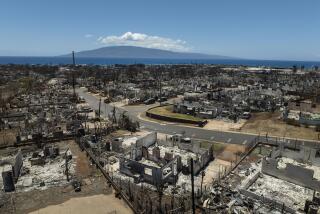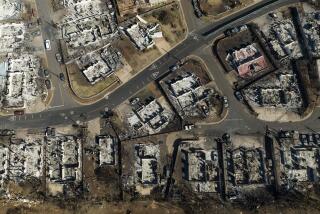Maui fire death toll at 99 with one-quarter of Lahaina searched: ‘Obviously no survivors’
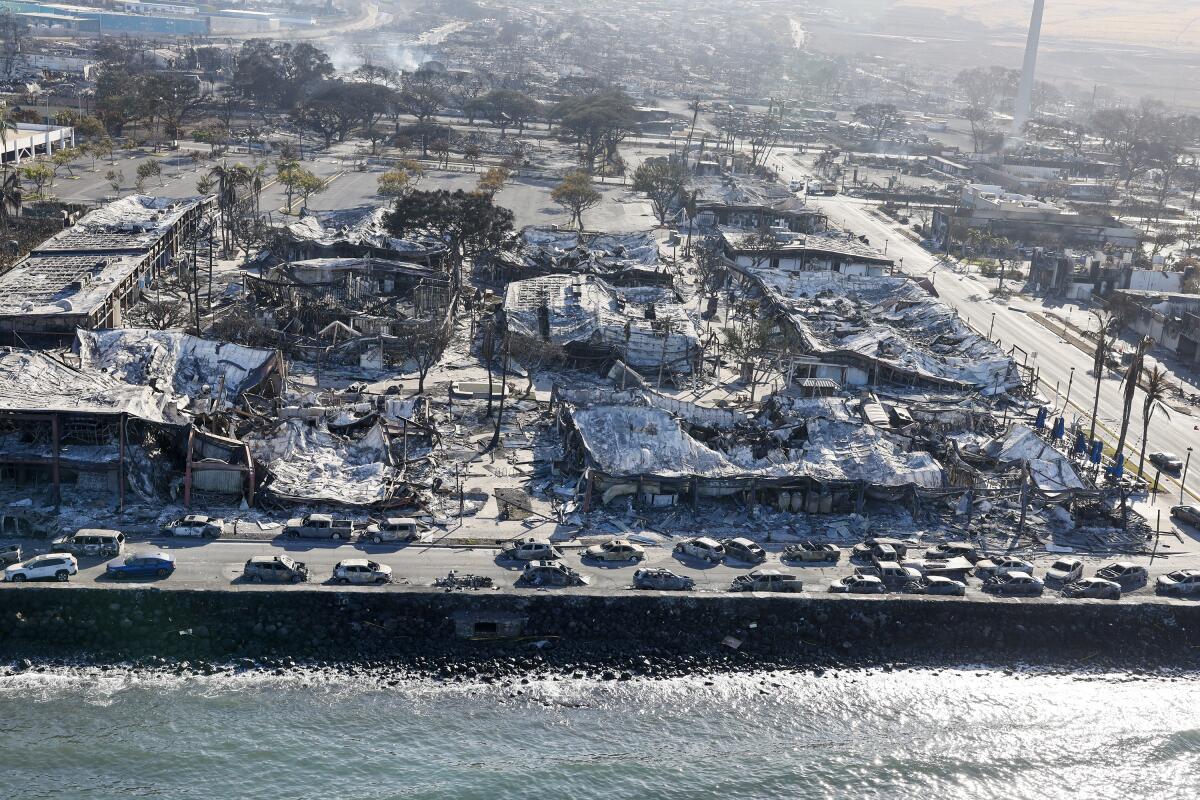
- Share via
Nearly a week after a wildfire incinerated the historic town of Lahaina, killing at least 99 people, search efforts are intensifying. As teams have combed through just 25% of the devastated area, the death toll is expected to climb significantly.
Twenty cadaver dogs and more than 90 workers with the Federal Emergency Management Agency are leading the search through the ash and rubble, Maui Police Chief John Pelletier said Monday. The identities of several of the victims are expected to be released publicly starting Tuesday, Pelletier said.
There are some close to the search who suspect the death toll from what is now the deadliest U.S. wildfire in a century could climb into the hundreds. When asked by CBS about the estimate, FEMA Administrator Deanne Criswell said: “If that’s what they’re telling you, I wouldn’t second-guess them.”
Fatalities have surpassed those from the 2018 Camp fire, which destroyed the Northern California town of Paradise, where at least 85 died.
Hawaii Gov. Josh Green said the number of dead would certainly rise. In an interview with “CBS Mornings” that aired Monday, the governor said there were “obviously no survivors left in the area.”
Experts say identifying the dead could take weeks, if not longer.
The Lahaina fire in West Maui ignited as firefighters focused on the Upcountry fire. What happened next — the deadliest U.S. wildfire in more than a century — left the historic town in ashes.
About 1,300 people are still unaccounted for, down from around 2,000 after cell service returned and family and friends were able to make contact, Green said. Crews are likely to find the remains of 10 to 20 people each day until search efforts cease, which he estimated could take 10 days.
“We are prepared for many tragic stories,” the governor said.
Recovery and identification efforts have faced scrutiny as families and friends wait for information. State crews are escalating their hunt through the charred debris at a disaster site described as unrecognizable, and other forensic anthropologists may be brought in soon, authorities said.
Only two of the nearly 100 victims counted so far have been identified using rapid DNA testing. Three have been identified using fingerprints. Pelletier has told families looking for loved ones to submit DNA samples to help with identifying any remains.
Jeff Hickman, a spokesperson for Hawaii’s Department of Defense, told NBC’s “Today” show that search crews were working diligently, “going street by street, block by block between cars, and soon they’ll start to enter buildings.”
At least 400 agents from FEMA are in Maui. Additional search-and-rescue teams with dogs were headed to the island, including one from the Los Angeles County Fire Department that arrived Sunday. Search efforts should move faster now, Hickman said, which can “hopefully bring some closure to those on Maui.”
Here is what we know about the origin of the Maui fire and how it so rapidly became an unstoppable force that tore through Lahaina.
Jeremy Greenberg, FEMA’s director of operations, said in a call with reporters Monday that officials were processing the remains “in a compassionate and caring way.”
Dr. Michael Baden, the former chief medical examiner of New York and a forensics expert, spoke about the long haul ahead for those attempting to identify victims. The rapid DNA test used for the first two identifications suggests authorities have set up an emergency lab on the island, he said.
But identifying remains from a wildfire is challenging, he said. DNA can be destroyed if temperatures reach 300 to 400 degrees Fahrenheit, rendering traditional collection methods, such as mouth swabs or from soft tissue, ineffective.
Authorities can use dental records or X-rays to identify victims, Baden said. Identifying approximate areas where remains were found — along a certain street or specific address, if possible — is crucial, he said, because authorities can then try to contact surviving family members for medical files. Authorities also may be able to extract DNA from drilling into thigh bones, Baden said.
Criswell, of FEMA, described Lahaina in an interview on CBS’ “Face the Nation” on Sunday as a “scene from an apocalyptic movie,” with rows of scorched cars lining the streets of a community that has been reduced to ash.
Search teams had mapped out the disaster zone and scoured about 3% of the targeted area as of Sunday, Criswell said, adding that some structures were partially standing, making search efforts challenging. The size of the searched area increased to 25% by Monday afternoon. Engineers are embedded with crews to help assess buildings’ stability.
As Hawaii begins to tally the damage and assess how to improve its safety procedures to address extreme fire weather, California can offer many lessons.
About 3,000 animals are estimated to be missing after the Maui fires, according to Maui Humane Society Chief Executive Lisa Labrecque. At least 367 lost-animal reports had been made as of Monday morning, and 52 animals have been found and taken in by Humane Society personnel, 12 of which required medical attention. Each animal found has its location recorded before it’s checked for identification and microchips to connect it with its owner.
“People are desperately searching for their pets, and they’ve been incredibly grateful to our team for any closure that we’ve been able to give them,” Labrecque said, adding that the remains of deceased animals should not be removed until they are catalogued.
The Lahaina fire, one of several that broke out last week on Maui, was 85% contained late Sunday, Maui County officials said. Maui Fire Department Chief Bradford Ventura said Monday that an aerial scan of the containment perimeter with infrared cameras was planned for Tuesday morning to locate any remaining hot spots.
An estimated 1,100 residents were in shelters. FEMA was set to begin paying for displaced residents to stay overnight in hotel rooms on the island, Greenberg said. The agency also planned to supply $700 one-time payments to help with food, water, baby formula and other basic necessities.
More than 2,200 structures were destroyed in Lahaina — 86% of which were residential — with an estimated damage of $5.6 billion, Green, the governor, said. Officials say the U.S. Small Business Administration is offering loans of up to $5 million for businesses and up to $500,000 for homeowners. Personal property loans are available for up to $100,000, public information officer Cynthia Cowell said.
“This way,” she said, “we can give people a little bit of comfort room, a chance to get back into their normal routine.”
Green said he ordered Anne E. Lopez, the state’s attorney general, to lead the investigation into what caused the fires and the overall response to the devastating blaze.
After first erupting last Tuesday, the fire was initially deemed to be out, but winds whipped up by far-off Hurricane Dora that reached up to 81 mph fanned the flames and spurred the blaze to travel about one mile every minute, Green said.
A Times review of Maui County’s Facebook page showed that the first report of a brush fire in Lahaina came in at 6:37 a.m. on Aug. 8, and evacuations were ordered within three minutes around Lahaina Intermediate School on the town’s northeastern edge. The fire erupted as crews were battling another wildfire farther east.
The sense of alarm seemed to fade by around 10 a.m., when Maui County said it had declared the Lahaina brush fire “100% contained,” although it did warn of power outages limiting the ability to pump water and a report of a downed electrical line in the area.
The blaze then flared up in the afternoon, racing toward communities on West Maui. Nearly all of central Lahaina was eventually reduced to ash.
Records indicate that neither the state nor the county activated sirens ahead of the fire, though other systems were used, including messages broadcast to television stations, radios and cellphones. But with the power out and communications systems down, many residents reported receiving no alerts.
Times staff writer Jeremy Childs contributed to this report.
More to Read
Sign up for Essential California
The most important California stories and recommendations in your inbox every morning.
You may occasionally receive promotional content from the Los Angeles Times.
